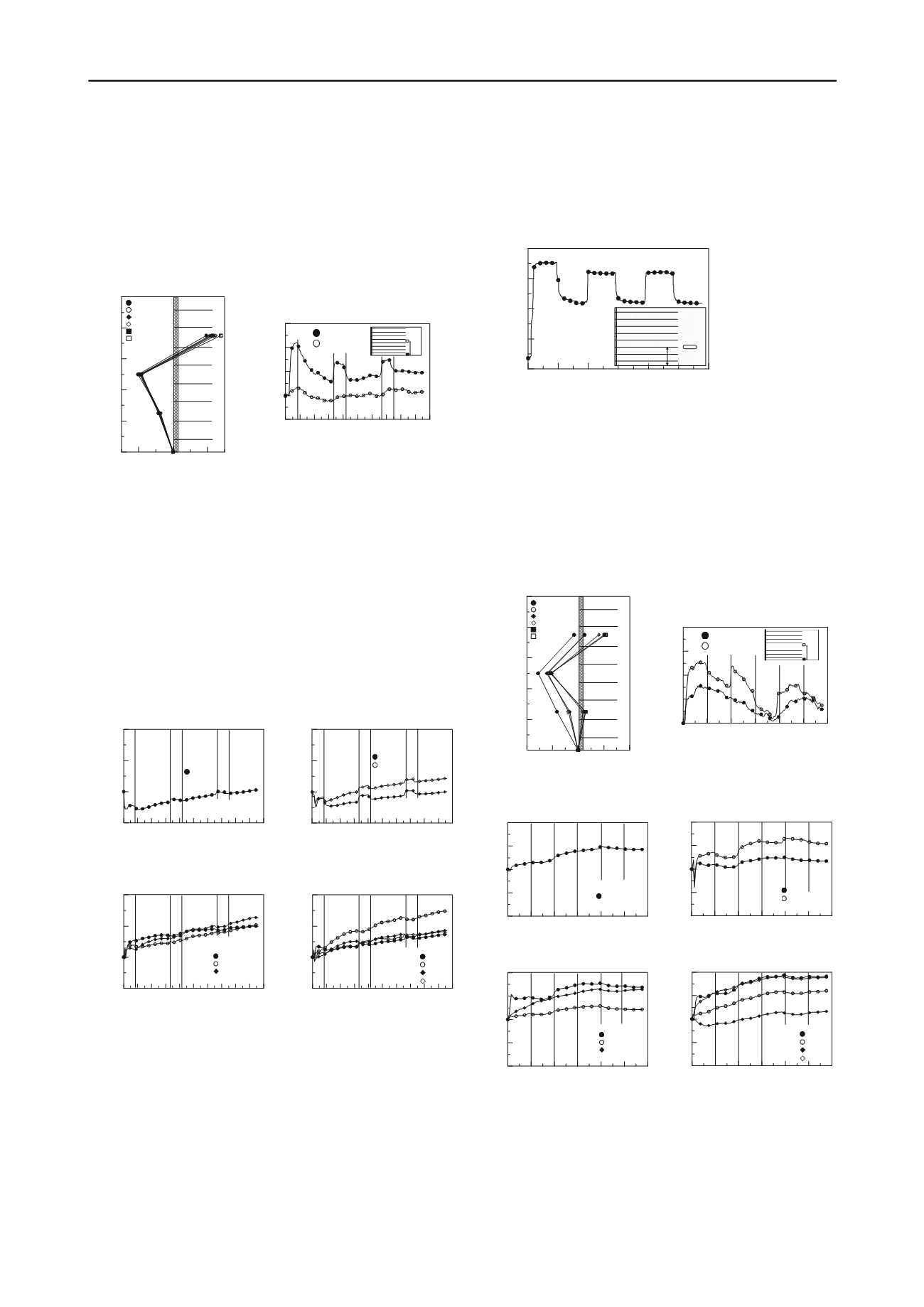
2133
Technical Committee 207 /
Comité technique 207
lasted for 8 hours for wetting. As shown in Figure 6(a), the wall
displacement increased about 1 mm during the 1
st
cycle of
wetting after which no significant increase was recorded. The
pore water pressures measured at the bottom and the mid-height
at the back of reinforced zone tended to increase during the first
wetting period as great as 4 kPa, followed by gradual decreases
during the ensuing 24 hour drying period as shown in Figure
6(b). As observed in the wall displacement, the largest increase
in the pore water pressure was measured during in the first
wetting period.
Shown in Figure 7 are the measured reinforcement strains in
the selected reinforcement layers. Of salient features are
twofold. First, the reinforcement strains tended to steadily
increase over the repeated wetting and drying cycles unlike the
wall displacements and the pore water pressures which showed
cycles of fluctuation during the wetting and draying process.
Second, larger strains, as great as 0.015%, are measured in the
upper reinforcement layers than in the lower layers due possibly
to the downward movement of wetting front caused by the
rainfall infiltration.
(a) 1
st
layer
(b) 3
rd
layer
(c) 5
th
layer
(d) 7
th
layer
Figure 7. Reinforcement strains (
)
h mm
rI
/
2.56
Figure 8 shows the time variation of volumetric water
content (
) measured at 160 mm above the wall base at the
back of the reinforced zone. As shown, the initial volumetric
water content of 0.05 at the measuring point sharply increased
to 0.35 after which it remained constant over the remaining
wetting period. During the drying period,
then sharply
decreased to 0.2 and remained constant during the entire drying
period. A similar trend can be observed in the following cycles
suggesting that the cycles of the wetting and drying with the
rainfall intensity and duration considered in this study may
increase the water content of the backfill soil.
The results shown here indicate that the repeated cycles of
wetting and drying associated with a heavy rainfall may induce
additional wall displacement and reinforcement strains in
GRSWs. Such results suggest that the weather induced wetting
drying has significant implications to GRSWs designed with
marginal factor of safety in terms of long-term stability.
Figure 8. Time variation of volumetric water content (
)
3.2 Effect of rainfall intensity
Figures 9 and 10 show the measured wall displacements and the
reinforcement strains for the case with a rainfall intensity of
18.7 mm/h. Note that the total rainfall was kept same at 450
mm as in the case of
h mm
I
r
/
2.56
but with a longer wetting
period of 24 hours. The discrepancies in the wall performance
between the two cases can therefore be thought to stem from the
rainfall intensity.
(a) 1
st
layer
(b) 3
nd
layer
(c) 5
th
layer
(d) 7
th
layer
Figure 10. Reinforcement strains (
)
h mm
rI
/
7.18
The direct comparison between the two cases reveals that the
case with the smaller rainfall intensity but with the longer
duration generally induces larger wall displacements and
reinforcement strains except for the pore water pressure
measured at the back of reinforced zone. Considering the
backfill soil being a high permeability soil, these results
(a) wall displacement
(b) pore pressure
Figure 6. Wall displacement and pore pressure (
)
h mm
rI
/
2.56
(a) wall displacement
(b) pore pressure
Figure 9. Wall displacement and pore pressure (
)
h mm
rI
/
7.18
0 10 20 30 40 50 60 70 80 90 100
Time (hours)
-0.01
0
0.01
0.02
Strain (%)
reinforcement strain
50mm
dist. from
wall facing
100mm
Rainfall
Rainfall
Rainfall
0 10 20 30 40 50 60 70 80 90 100
Time (hours)
-0.01
0
0.01
0.02
Strain (
)
Rainfall
Rainfall
Rainfall
reinforcement strain
50mm
dist. from
wall facing
100mm
150mm
0 10 20 30 40 50 60 70 80 90 100
Time (hours)
-0.01
0
0.01
0.02
Strain (
)
Rainfall
50mm
dist. from
wall facing
Rainfall
Rainfall
reinforcement strain
0 10 20 30 40 50 60 70 80 90 100
Time (hours)
-0.01
0
0.01
0.02
Strain (
)
Rainfall
Rainfall
Rainfall
reinforcement
strain
50mm
dist. from
wall facing
100mm
150mm
200mm
0 25 50 75 100 125 1
Time (hours)
50
0
0.1
0.2
0.3
0.4
Vol. water content (
)
h=160mm
tensiometer
-1
0
1
Lateral displacement(mm)
0.0
0.2
0.4
0.6
0.8
1.0
Elevation from base (z/h)
1
st
wetting (8hrs)
1
st
drying (32hrs)
2
nd
wetting(40hrs)
2
nd
drying (64hrs)
3
rd
wetting (74hrs)
3
rd
drying (92hrs)
( ) elapsed time
0 10 20 30 40 50 60 70 80 90 10
Ti
0
me (hours)
-2
0
2
4
6
Pore water pressure (kPa)
h=250mm
h=0mm
h=250mm
h=0mm
-4 -2 0
2
4
Lateral disp
0.0
0.2
0.4
0.6
0.8
1.0
Elevation from base (z/h)
1
st
wetting (24hrs)
1
st
drying (48hrs)
2
nd
wetting (72hrs)
2
nd
drying (96hrs)
3
rd
wetting (120hrs)
3
rd
drying (144hrs)
( ) elapsed time
0 25 50 75 100 125 150
Time (hours)
0
10
20
30
40
Pore water pressure (kPa)
h=250mm
h=0mm
h=250mm
h=0mm
lacement(mm)
0 25 50 75 100 125 150
Time (hours)
-0.02
-0.01
0
0.01
0.02
Strain (%)
reinforcement strain
50mm
dist. from
wall facing
100mm
Rainfall
Rainfall
Rainfall
0 25 50 75 100 125 150
Time (hours)
-0.02
-0.01
0
0.01
0.02
Strain (
)
Rainfall
50 mm
dist. from
wall facing
Rainfall
Rainfall
reinforcement strain
0 25 50 75 100 125 150
Time (hours)
-0.02
-0.01
0
0.01
0.02
Strain (
)
Rainfall
Rainfall
Rainfall
reinforcement strain
50mm
dist. from
wall facing
100mm
150mm
0 25 50 75 100 125 150
Time (hours)
-0.02
-0.01
0
0.01
0.02
Strain (
)
Rainfall
Rainfall
Rainfall
reinforcement
strain
50mm
dist. from
wall facing
100mm
150mm
200mm


